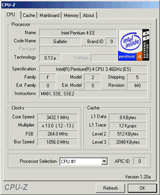Pentium 4 Extreme Edition 3.46GHz 1066MHz FSB
Vital Signs, Temps, Overclocking & D925XECV2 BIOS

Intel has been refining and tuning the Pentium 4 LGA775 heatsink design since its initial release in June. The result is a slightly taller sink with a shrouded fan that seems to spin a bit more quietly with its scooped blade design.
|
The retention mechanism for the stock Pentium 4 HSF is the same press fit cam loaded design that we saw in the first iteration for the LGA775 socket assembly, only this time out there seems to be significantly more insertion force required to get these clips to lock into place. As a result, it "feels" as though the retention pins themselves now actually provide a bit more downward pressure on the socket once locked into place.
Pentium 4 Extreme Edition 3.46GHz - LGA775 at ideal and load
Upon inspection of the processor's chip ID taken with the CPUZ utility, you'll note that this is indeed an Intel "Gallatin" core based processor, identical to previous versions of what is now known as the Pentium 4 Extreme Edition processor. As you'll note, the FSB is set to 266MHz with a 13X multiplier on this chip, which when driven though the chipset's "Quad-Pumped" architecture, yields an effective 1066MHz system bus speed.
Thermal characteristics of the new 3.46GHz Extreme Edition are still in the same ballpark as previous 800MHz FSB versions in the LGA775 package. On an open air test bench environment, we observed idle temps at 36ºC and full load temps at 55ºC. To take this one step further we've observed full load temps running a distributed computing application like Folding At Home in a closed ATX chassis environment, reaching a stabilized 61ºC with a fair amount of ventilation in the case. Make no mistake, this chip isn't any cooler than previous versions. We've heard rumblings that Intel is refining its process technology in future iterations of upcoming Prescott core processors with a 2MB L2 cache and 1066MHz FSB that will mitigate these higher thermals to a certain extent. We'll cross our fingers on that one because all of these chips are really cooking at the moment.
|
Though the new P4 EE 3.46GHz chip was humming along under full load with thermals hot enough to fry us a hearty breakfast sunny side up, we still thought it could handle a bit of overclocking, so we fired up the D925XECV2's "burn-in" mode in the BIOS menu.
Our results were typical of previous-generation 3.4GHz Extreme Edition CPUs, clocking in at a default voltage of 3.8GHz. This was set with the D925XECV2 board's "+ 10%" mode BIOS option, which is a limitation of the Intel motherboard more than anything else. Perhaps a more interesting datapoint is the fact that our system bus speed is also now at 1173MHz, which is derived from a 293MHz base clock and equates to 586MHz DDR2 DRAM timings.
|
||||||
Just for giggles we thought it would be interesting to take you through a quick tour of a few of the D925XECV2's BIOS screens. Again, Intel BIOS options aren't set up for the "overclocker" or enthusiast in mind, but they give the end user access to many settings that are required to tune the board for optimal performance.
 |
 |
 |
 |
 |
Again, this Intel board offers "burn in mode" for both CPU and Memory timings but has no voltage adjustments for either. You can also over-speed and tweak PCI Express links to a certain degree, but we're not sure there is any real potential upside benefit here to offset any sacrifices you'll make in stability. All told, the D925XECV2's BIOS does just what it was intended to do, nothing more nothing less. Enthusiasts looking to squeak out additional performance through overclocking and voltage settings will be left a bit flat. You do however have the saving grace of being able to tweak memory timings within the BIOS, which will certainly help get some of the system's inherent DDR2 memory latency in line somewhat.













